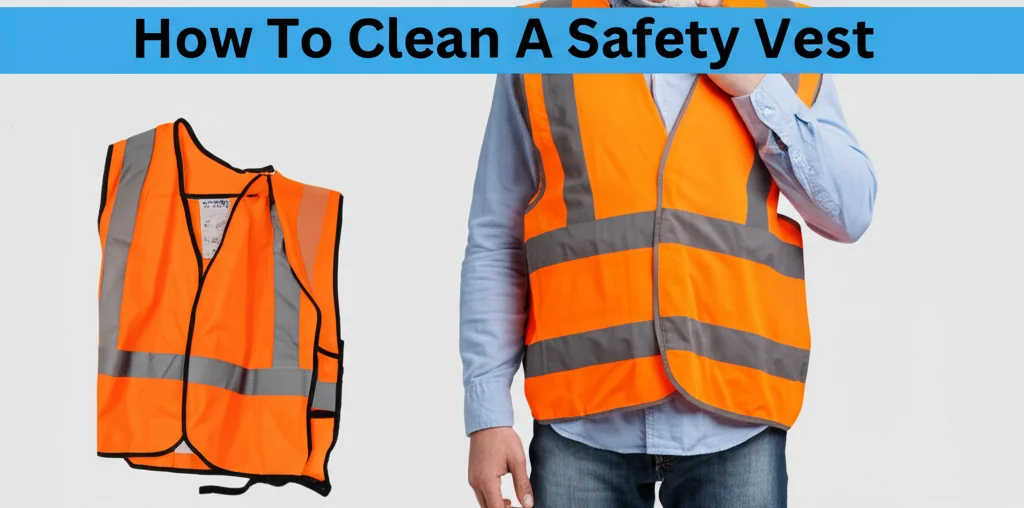· Home & Safety · 7 min read
How To Clean A Safety Vest

Keeping Your Guardian Bright: How To Clean A Safety Vest
Have you ever stopped to think about how much you rely on your safety vest? It’s a crucial piece of equipment, whether you’re working roadside, cycling, or simply need to be seen. But a dirty safety vest loses its effectiveness. This article will show you exactly how to clean a safety vest, ensuring it continues to provide the visibility you need. We’ll cover everything from checking the label to drying your vest properly, keeping you safe and seen.
Takeaway:
- Always check the care label first.
- Gentle washing is key to preserving reflectivity.
- Air drying is the safest method.
- Avoid harsh chemicals and abrasive cleaners.
Quick Answer: To clean a safety vest, check the label for specific instructions. Most vests can be hand-washed or machine-washed on a gentle cycle with mild detergent. Avoid bleach and fabric softeners, and always air dry to prevent damage to the reflective material.
Understanding Your Safety Vest Material
Before you start, it’s important to know what your safety vest is made of. Different materials require different cleaning approaches. Most safety vests are constructed from polyester or a polyester blend, which is relatively easy to care for. However, the reflective tape is the most sensitive part.
- Polyester: This is the most common material and generally holds up well to washing.
- Mesh: Some vests have mesh panels for breathability. These can be more delicate.
- Reflective Tape: This is the critical component for visibility. Harsh chemicals or abrasive cleaning can damage it, reducing its effectiveness.
- High-Visibility Fabrics: These are often treated with special coatings to enhance brightness.
Knowing your vest’s composition will help you choose the right cleaning method. If you’re unsure, always err on the side of caution and opt for a gentler approach. You can also find more information on caring for workwear at resources like https://www.beacleaner.com/how-to-clean-a-harness.
Decoding the Care Label: Your First Step
The care label is your best friend when it comes to cleaning any garment, and a safety vest is no exception. It provides specific instructions from the manufacturer. Always, always check the label before you do anything else.
- Washing Symbols: Look for symbols indicating whether the vest is machine washable, hand washable, or dry clean only.
- Water Temperature: The label will specify the maximum water temperature for washing.
- Drying Instructions: Pay attention to whether the vest can be tumble dried, and if so, at what temperature.
- Bleach/Ironing: The label will indicate if bleach or ironing is permitted.
Ignoring the care label can lead to damage, fading, or a reduction in the vest’s reflectivity. If the label is missing or illegible, proceed with extreme caution and consider hand washing as the safest option.
Hand Washing: The Gentle Approach
Hand washing is the safest method for cleaning a safety vest, especially if you’re unsure about the material or the care label is unclear. It’s gentle and allows you to control the entire process.
- Prepare the Solution: Fill a basin or sink with lukewarm water and add a small amount of mild detergent. Avoid harsh chemicals or bleach.
- Submerge and Soak: Submerge the vest in the soapy water and gently agitate it. Let it soak for 15-30 minutes.
- Gentle Scrubbing: Use a soft brush or your hands to gently scrub any visible dirt or stains. Avoid scrubbing the reflective tape too vigorously.
- Rinse Thoroughly: Rinse the vest thoroughly with clean, lukewarm water until all traces of detergent are gone.
- Press Out Excess Water: Gently press out excess water – do not wring or twist the vest.
Hand washing is a great option for maintaining the quality of your safety vest. For other delicate cleaning tasks, you might find information on cleaning other items like https://www.beacleaner.com/how-to-clean-a-cameo helpful.
Machine Washing: When It’s Okay
If the care label allows, you can machine wash your safety vest. However, it’s crucial to take precautions to protect the reflective material.
- Use a Laundry Bag: Place the vest in a mesh laundry bag to protect it from abrasion during the wash cycle.
- Gentle Cycle: Select the gentle or delicate cycle on your washing machine.
- Cold Water: Use cold water to prevent fading and damage to the reflective tape.
- Mild Detergent: Use a mild detergent specifically designed for delicate fabrics. Avoid bleach and fabric softeners.
- Avoid Other Items: Wash the safety vest separately or with similar delicate items.
Machine washing can save time, but it’s essential to follow these guidelines to ensure your vest remains effective. Remember, a clean home is a safe home, and you can learn more about comprehensive cleaning services at https://www.beacleaner.com/how-much-to-clean-out-a-house.
Drying Your Safety Vest: Air Drying is Best
Drying is just as important as washing. Heat can damage the reflective tape and shrink the fabric. Air drying is always the safest option.
- Lay Flat: Lay the vest flat on a clean, dry surface, away from direct sunlight.
- Hang to Dry: Alternatively, you can hang the vest on a plastic hanger, avoiding metal hangers that could cause rust stains.
- Avoid Direct Heat: Never put a safety vest in the dryer, as the heat can damage the reflective material.
- Ensure Complete Dryness: Make sure the vest is completely dry before storing it.
Proper drying will help maintain the vest’s shape, reflectivity, and overall lifespan.
Dealing with Stubborn Stains
Sometimes, a simple wash isn’t enough to remove stubborn stains. Here’s how to tackle them:
- Pre-Treat: Apply a small amount of mild detergent directly to the stain and let it sit for 15-30 minutes.
- Gentle Scrubbing: Gently scrub the stain with a soft brush or cloth.
- Avoid Harsh Chemicals: Never use bleach, ammonia, or other harsh chemicals, as they can damage the reflective tape.
- Repeat if Necessary: If the stain persists, repeat the process.
For particularly difficult stains, consider consulting a professional cleaning service. You can also find helpful tips on cleaning other items around your home, such as https://www.beacleaner.com/how-to-clean-a-doormat.
Maintaining Visibility: Regular Cleaning is Key
Cleaning your safety vest isn’t just about aesthetics; it’s about safety. Dirt and grime can significantly reduce its reflectivity, making you less visible in low-light conditions. Make cleaning a regular part of your maintenance routine.
- Inspect Regularly: Check your vest for dirt, grime, and damage before each use.
- Clean as Needed: Clean the vest whenever it becomes visibly dirty.
- Proper Storage: Store the vest in a clean, dry place, away from direct sunlight.
By following these simple steps, you can ensure your safety vest remains a reliable guardian, keeping you visible and safe in any situation.
Frequently Asked Questions
Q: Can I use bleach on my safety vest? A: No, absolutely not. Bleach can damage the reflective tape and weaken the fabric, reducing its effectiveness. Always use a mild detergent and avoid harsh chemicals.
Q: How often should I clean my safety vest? A: Clean your safety vest whenever it becomes visibly dirty or after each use if it’s exposed to heavy grime. Regular cleaning ensures optimal reflectivity.
Q: Can I iron my safety vest? A: Check the care label. If ironing is permitted, use a low heat setting and iron on the reverse side, avoiding the reflective tape.
Q: What if the reflective tape is peeling off? A: If the reflective tape is peeling, the vest should be replaced. Damaged reflective tape significantly reduces visibility and compromises safety.
Q: Is it okay to dry clean my safety vest? A: Check the care label. Some vests may be dry cleanable, but it’s generally best to avoid dry cleaning if possible, as the chemicals can damage the reflective material.
Conclusion: Stay Safe, Stay Visible
Keeping your safety vest clean is a simple yet vital step in ensuring your safety. By following the guidelines in this article – checking the care label, using gentle cleaning methods, and air drying – you can maintain the vest’s reflectivity and prolong its lifespan. Remember, a clean safety vest is a visible safety vest. Don’t compromise your safety; make cleaning a regular habit. If you need help with other cleaning tasks around your home, Beacleaner offers a wide range of professional cleaning services.
- safety vest cleaning
- high visibility clothing
- workwear care
- reflective vest




